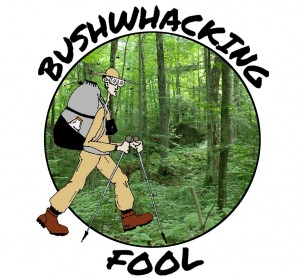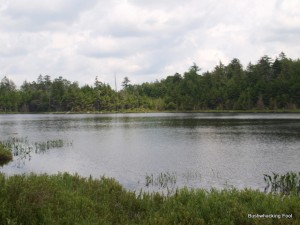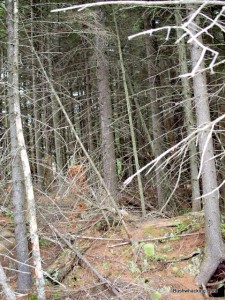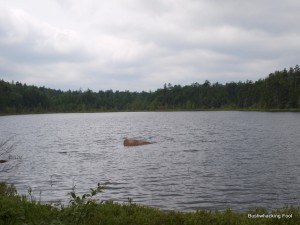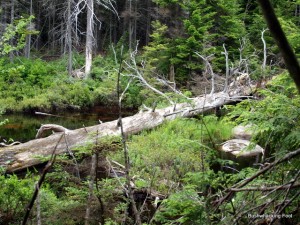The following is a description of an eight-day bushwhacking adventure into some of the most remote areas within the Five Ponds Wilderness in the northwestern Adirondacks. The trip includes traversing areas of intense blowdown along the oddly-shaped Oven Lake, exploring a cluster of wilderness ponds and following the wild Robinson River. The second part of day six includes getting lost by following the wrong stream but finally making it to Gal Pond anyways.
Section Stats:
Date: July 3, 2011
Length: 0.8 miles (1.3 miles for the day)
Difficulty: Moderate
After a couple attempts to depart Cracker Pond along its outlet stream, I finally arrived at an old beaver pond slowly transitioning to a meadow. Now it is time to continue on to Gal Pond.
I cross on one of the logs lying across the muddy remnants of the beaver meadow and quickly enter a cluster of young spruces near the old burst beaver dam. I use the stream as a guide as it flows in the same direction I plan on following all the way to Gal Pond. As the stream begins to cut through a steep ravine, I keep up slope as much as possible while continuing the ascent through an increasingly more hardwood forest.
View Day Six, Part Two in a larger map
My apprehension grows as my compass indicates my heading is becoming more and more northeast. When the stream flows into another beaver pond, I descend along its edge and continue following its southern shore. Unlike the last beaver dam, this one is obviously active as recent stumps of young hardwoods are abundant along the border. With the numerous hardwood trees scattered along the edge of this pond, it should be able to provide sustenance for a beaver family for years to come.
My concern about the bearing change of the stream compels me to consult my Garmin GPS. My suspensions prove correct as the GPS indicates I have moved way too far east; evidently at some point I mistakenly followed a minor tributary instead of the main stream flowing between Cracker and Gal Ponds.
The Garmin eTrex Legend HCx is a wonderful handheld GPS, which allows for the topographic information to be downloaded and used in the backcountry (like this one). This is a very important feature given the gadget’s weatherproofing; it is no longer necessary to endure a soaking wet map while bushwhacking during heavy rainstorms.
All information points towards me following the wrong stream. I am uncertain where this mistake occurred but I suspect it was just past the burst dam back at the sliver of beaver pond.
Using my compass, I set a new bearing of 309 degrees. Unfortunately my new heading takes me right over the beaver pond. Since I do not relish attempting a swim across, I backtrack to the stream before the beaver pond and then head in the appropriate direction.
After crossing, I ascend out of the ravine cradling the stream I mistakenly followed since the previous beaver pond. Upon cresting the top of the ravine I soon find myself at the edge of an open meadow choked with grasses and/or sedges. Opposite of my position across the meadow is an apparently steep, wooded ridge. Open sky lies just beyond the ridge, where my map and GPS indicate Gal Pond should be located.
The meadow is very soggy, so to avoid the inevitable wet boots I retreat back into the forest and head around to the east. Since my plan is to bushwhack along the northern shore of Gal on my way to West Pond, it makes more sense to stay back from the pond’s shore until absolutely necessary. Plus, I had no desire to fight my way up the narrow ridge and immediately descend down to the pond’s shoreline.
I avoid going through a grove of spruces along the eastern shore of Gal Pond. Instead I circle around its edge staying to the east, waiting for a good opportunity to make a break west toward the pond’s shoreline.
Upon reaching the Gal outlet stream, I follow along it upstream as best I can. The spruce/fir forest becomes much denser and younger as I approach the pond. Frequent blowdowns of mostly larger trees mingle in with the denser young ones.
I finally reach the shoreline at the pond’s easternmost point after weaving my way through the thick stand of conifers. From this position I get a clear view of the attractive water body. I shed my backpack and prepare to savor the view despite the threatening sky unfolding before me above the pond. When I look back into the forest from whence I just came, I cannot help but wonder how I possibly got through there to this point.
Several large rocks stick up out of the water just off shore in this area. Most are toward the opening of the outlet stream but one is further off to the southwest. Most of them are covered with blotches of bird poop. Since the pond was once called Gull Pond, perhaps this poop was left by the pond’s previous namesake.
On top of the biggest boulder is a bobbing scurrying around near the water’s edge. The compulsive bobbing appears to indicate some apprehensiveness with regards to my presence on shore. The sandpiper moves constantly around a boulder before flying off to the next boulder to repeat the behavior all over again. Its hurried movements make it impossible to capture a single photograph with the sandpiper’s silhouette at the very top of one of the rocks despite my many attempts.
With the sky looking its threatening since the day started, I pack up my photography equipment and begin my trek to West Pond. As I retrace my path along the Gal outlet, I pass a large, downed eastern white pine lying across the stream just a short distance from the pond’s shoreline. I stop and contemplate using it as a bridge to cross the outlet stream despite all the intact branches along its length. Instead I continue downstream where the stream should narrows as it drops to the east.
An old topographic map indicates a trail once traversed this area, crossing the stream just east of Gal Pond (then known as Gull Pond) before climbing Greenfield Mountain on the way to High Falls on the Oswegatchie River. I keep an eye out for some remnants of the old trail as I weave my way through the blowdown infested and relatively dense forest but when I see a beaver swale ahead I decide to cross the stream and head west back toward the pond. Finding the trail (if such a thing is even possible now) will have to wait until another visit in the future.
The shoreline is dense with spruce/fir, so I stay a good distance off into the forest as I traverse around the northwest shore of Gal Pond. The forest is beautiful here, full of numerous large eastern white pine, yellow birch and spruce. But the gigantic eastern hemlocks are especially impressive; standing tall and towering above all else, survivors of a time long past. This is an example of the primeval Adirondack forest; relatively untouched by man. Although uphill from the pond’s shoreline, the relative flatness of this area makes it an attractive prospective camping area for a future trip.
I bushwhack through pleasant mature forest for about two thirds the length of Gal’s northwestern shore before returning to the shoreline for one last look before heading to West Pond. I find an opening in the forest offering a pretty view of almost the entire pond.
From my vantage point, I notice some open rocks running down to the shoreline just south of where I first arrived at Gal Pond earlier. Although it may require a supreme effort to get through the dense spruce/fir, there rocks probably allow a dry access to the shore of the pond.
Gal Pond has a more robust aquatic vegetation population than most of the other water bodies encountered on this trip. This is especially true along the middle section of the northwestern shore. Pickerel weed is very common here, as are some small, yellow-flowered lillypads.
I locate a dry place to sit and enjoy another late lunch before heading on to my final destination of the day: West Pond. As I set up my lunch spread I am serenaded by a bullfrog’s low grunts echoing across the pond while a hooded merganser flies overhead.
Be sure to return later in the week to read about the conclusion of my bushwhack to West Pond. In the meantime, if you have ever been to Gal Pond before then feel free to share your experiences in the comments below.
Affiliate Disclaimer: Some links within this blog post may send you to a retailer website. If you chose to purchase any product at that site at that time the author will receive a small commission. These commissions provide compensation for the author’s time and effort necessary to provide the amazing content at the Bushwhacking Fool.
